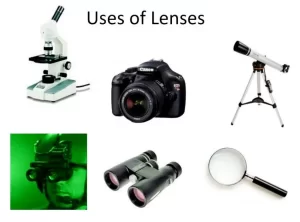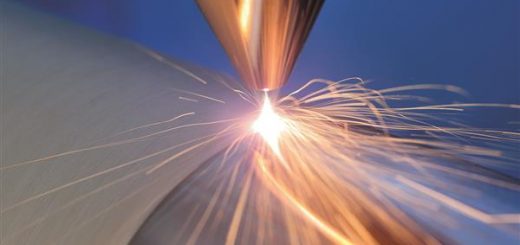Types and uses of lenses in our life and special concepts related to the lenses
The lens is the transparent medium that refracts the light and it is limited to two spherical surfaces, The lens is usually made of glass or plastic, The lens is a transparent optical device that affects the focus of a light beam through refraction.
Lenses
A simple lens consists of a single piece of material while a compound lens consists of several simple lenses (the elements), usually along a common axis. because of the way they are manufactured, Lenses may be cut or ground after manufacturing to give them a different shape or size.
The lenses are made from transparent materials such as glass, then ground and polished to the desired shape, The lens can focus the light to form an image, unlike a prism, which refracts the light without focusing.
The devices that similarly refract radiation other than visible light are also called the lenses such as microwave lenses electron lenses, explosive lenses, or acoustic lenses.
Importance of lenses
The lenses are used in many things, They are used in medical eyeglasses either for reading or walking, They are used in wars, and the leaders use binoculars to follow the battles. Convex lenses are used in projectors, multijunction solar cells, and peepholes in doors.
The person who fixes the watches uses a magnifier lens to see the minute parts of the watches, The lenses are used in the manufacture of many things as projectors, cameras, and magnifying lenses.
The lenses are used in designing some optical devices such as Telescopes which are used for the formation of enlarged images of heavenly bodies. Lenses can be used in a magnifying glass, they can be used in prosthetics for the correction of visual impairments, They can attenuate light, They are used in imaging systems, and they can be used in radar systems.
The lenses are used in Microscopes which are used to form magnified images of tiny bodies that can not be seen with the naked eye and they are used in making medical glasses to treat vision defects such as myopia and hypermetropia.
Lenses are useful in many ways, from helping us see clearly to capturing the world around us. Lenses play a vital role in various fields, from science and medicine to entertainment and technology. By bending and focusing light, they allow us to see the world in greater detail, explore the unseen, and capture our experiences.
Our eyes have natural lenses that focus light on the retina. Glasses and contacts use corrective lenses to bend light and improve blurry vision. Convex lenses help with farsightedness, while concave lenses address nearsightedness.
Lenses can be used to collimate and focus laser light for various applications, from cutting materials to performing delicate surgeries. Projectors are used in presentations, movies, and educational settings. Projectors use lenses to project an image onto a screen by focusing light from a lamp through a lens system, while eyeglasses and sunglasses often incorporate lenses to protect our eyes from sunlight.
Corrective lenses in eyeglasses and contact lenses bend light rays to focus them properly on the retina in our eye. This allows people with nearsightedness, farsightedness, or astigmatism to see clearly.
Cameras: Lenses capture and focus light to create sharp images on film or digital sensors. The lens system plays a crucial role in determining factors like zoom, aperture, and overall image quality, and the lenses in our smartphones help us take sharp pictures.
Types of lenses
Lenses are classified by the curvature of the two optical surfaces, The lens is biconvex (or double convex, or just convex) if both surfaces are convex, When both surfaces have the same radius of curvature, the lens is equiconvex, The lens with two concave surfaces is biconcave (or just concave).
When one of the surfaces is flat, the lens is plano-convex or plano-concave depending on the curvature of the other surface, The lens with one convex and one concave side is convex-concave or meniscus, this type of lens is most commonly used in corrective lenses.
When the lens is biconcave or plano-concave, the collimated beam of light passing through the lens diverges (spread); the lens is called the negative or diverging lens, The beam, after passing through the lens, appears to emanate from a particular point on the axis in front of the lens, For a thin lens in air, the distance from this point to the lens is the focal length, though it is negative with respect to the focal length of a converging lens.
Convex-concave (meniscus) lenses can be either positive or negative, depending on the relative curvatures of the two surfaces, The negative meniscus lens has a steeper concave surface and is thinner at the centre than at the periphery, Conversely, the positive meniscus lens has a steeper convex surface and is thicker at the centre than at the periphery. Lenses are magnifying glasses with curved sides.
Lenses are categorized as simple lenses or compound lenses. The simple lens is a single piece of magnifying material while the compound lens consists of several simple lenses arranged along a common axis, Optical aberrations are found in simple lenses while this property is eliminated in the compound lens, The magnification of the compound lens can be adjusted as per the user’s requirements.
The aspheric lens is known as a non-spherical lens, Aspheric lens is the lens whose surface is not part of a sphere or a cylinder, The complex surface of the aspheric lens reduces or eliminates optical aberrations as compared to a simple lens, the single aspheric lens can replace the combination of simple lenses resulting in a system with a much-reduced size.
Cylindrical Lenses have a curvature along only one axis, they convert laser diode elliptical light into a round beam or focus light into a line, such as motion picture anamorphic lenses. Fresnel lens is a lens whose optical surface is divided into narrow rings, This allows the lens to be much thinner and lighter than conventional lenses. Lenticular lenses are a group of microlenses that are used in lenticular printing, They produce images that have an illusion of depth.
Lenses are classified into two types according to the shape and purpose of the lens, Concave lens and Convex lens, The convex lens is thick at the center and has less thickness at the tips, It collects the light rays falling on it, So, it is called the converging lens. The concave lens is thin at its center and thicker at the tips, It separates the light rays, So, it is called the diverging lens.
Concave lens
The concave lens is a type of lens with at least one side curved inwards, The concave lens with both sides curved inward is known as a biconcave lens, Concave lenses are diverging lenses, that spread out light rays that have been refracted through it, They can diverge a parallel beam of light, For a concave lens, the edges are wider than the centre or the centre is thinner than the edges, Concave lenses are used in spectacles to overcome myopia or short-sightedness.
The concave lens produces a smaller image for the viewer, The focal point of the concave lens is the point from which the light rays parallel to the axis seem to diverge, after passing through the lens, The distance from the optical centre of the lens to the focal point is called the focal length of the lens.
The concave lens always generates a virtual image, It can never form a real image, The image is formed on the same side of the lens as the object, thus can be seen in the lens only and cannot be formed in a screen and as the distance of the object from the optical centre increases the size of the image decreases.
Convex Lens
The convex lens is a lens with an outward curve, Unlike the concave lens, the thickness at the centre of the convex lens is more than the thickness at the edges of the lens, Convex lenses are converging lenses, They can converge a parallel beam of light into the focal point of the convex lens.
The convex lens with one side flat is called a Plano-convex lens, The lens found in the human eye is a prime example of the convex lens, Another common example of the convex lens is the magnifying glass that is used to correct Hypermetropia or long-sightedness, Convex lenses are used in cameras as they can focus the light and produce a clear image, Convex lenses are used in compound lenses that are employed in magnifying devices such as microscopes and telescopes.
Special concepts related to the lenses
The center of the curvature of the lens face (C) is the center of the sphere, where this face is a part of it, The optical center of the lens is a point inside the lens that lies on the principal axis in the mid-distance between its faces.
The radius of curvature of the face of the lens is (r) half the diameter of the sphere, where this face is a part of it, The principal axis is the straight line that joins between the two centers of curvature of the lens passing by the optical center of the lens.
The secondary axis is any line that passes by the optical center of the lens except the principal axis, The focal length of the lens (f) is the distance between the focus and the optical center of the lens, (f = ½ r).
The focus of the lens (F) (the principal focus) is the point of collection of the refracted light rays (in the convex lens) or their extensions (in the concave lens), It is produced when a beam of parallel rays falls parallel to the principal axis of a lens.
The focus of the lens is real in the case of the convex lens and it is virtual in the case of the concave lens, Each lens has only one principal axis and more than one (uncountable number) of secondary axes. The lens has two centers of curvature and it has two foci because it has two circular surfaces.
You can follow science online on YouTube from this link: Science online
You can download Science online application on Google Play from this link: Science online Apps on Google Play
Lenses use, types, Convex lens, Concave lens, Vision defects, Contact lenses & Cataract
Properties of the formed images by convex lens and concave lens
The uses of lenses to treat vision defects
The properties of the image formed by a plane mirror
Uses of the concave mirror and the convex mirror in our daily life





Wonderful topic, but how about calculations and how it can be made.
You are welcome , Thank you very much for your comment
The properties of the formed images by convex lens and concave lens in this article
You will find How the images are formed and the calculations
https://www.online-sciences.com/technology/properties-of-the-formed-images-by-convex-lens-and-concave-lens/
It is helpfull for all lenses purpose
Thank you very much
really good